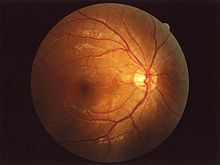- Ophthalmoscopy
-
Ophthalmoscopy Intervention
Ophthalmoscopic exam: the medical provider would next move in and observe with the ophthalmoscope from a distance of one to several cm.MeSH D009887  An ophthalmogram, showing the optic disc as a bright area on the right where blood vessels converge. The dark spot to the left of the centre is the macula.
An ophthalmogram, showing the optic disc as a bright area on the right where blood vessels converge. The dark spot to the left of the centre is the macula.
Ophthalmoscopy (funduscopy or fundoscopy) is a test that allows a health professional to see inside the fundus of the eye and other structures using an ophthalmoscope (or funduscope). It is done as part of an eye examination and may be done as part of a routine physical examination. It is crucial in determining the health of the retina and the vitreous humor.
Contents
Types
It is of two major types:
- Direct ophthalmoscopy one that produces an upright, or unreversed, image of approximately 15 times magnification.
- Indirect ophthalmoscopy one that produces an inverted, or reversed, direct image of 2 to 5 times magnification.
Features Direct ophthalmoscopy Indirect ophthalmoscopy Condensing lens Not Required Required Examination distance As close to patient's eye as possible At an arm's length Image Virtual, erect Real, inverted Illumination Not so bright; so not useful in hazy media Bright; so useful for hazy media Area of field in focus About 2 disc diameters About 8 disc diameters Stereopsis Absent Present Accessible fundus view Slightly beyond equator Up to Ora serrata i.e. peripheral retina Examination through hazy media Not possible Possible Each type of ophthalmoscopy has a special type of ophthalmoscope:
- The direct ophthalmoscope is an instrument about the size of a small flashlight (torch) with several lenses that can magnify up to about 15 times. This type of ophthalmoscope is most commonly used during a routine physical examination.[1]
- An indirect ophthalmoscope, on the other hand, constitutes a light attached to a headband, in addition to a small handheld lens. It provides a wider view of the inside of the eye. Furthermore, it allows a better view of the fundus of the eye, even if the lens is clouded by cataracts.[1] An indirect ophthalmoscope can be either monocular or binocular. It is used for peripheral viewing of the retina.
Indications
Ophthalmoscopy is done as part of a routine physical or complete eye examination.
It is used to detect and evaluate symptoms of retinal detachment or eye diseases such as glaucoma.
In patients with headaches, the finding of swollen optic discs, or papilledema, on ophthalmoscopy is a key sign, as this indicates raised intracranial pressure (ICP) which could be due to hydrocephalus, benign intracranial hypertension (aka pseudotumor cerebri) or brain tumor, amongst other conditions. Cupped optic discs are seen in glaucoma.
In patients with diabetes mellitus, regular ophthalmoscopic eye examinations (once every 6 months to 1 year) are important to screen for diabetic retinopathy as visual loss due to diabetes can be prevented by retinal laser treatment if retinopathy is spotted early.
In arterial hypertension, hypertensive changes of the retina closely mimic those in the brain, and may predict cerebrovascular accidents (strokes).
Dilation of the pupil
To allow for better inspection through the pupil, which constricts because of light from the ophthalmoscope, it is often desirable to dilate the pupil by application of a mydriatic agent, for instance tropicamide.It is primary ophthalmologist equipment.
History
Although the ophthalmoscope was originally invented by Charles Babbage in 1847, it was not until it was independently reinvented several years later by Hermann von Helmholtz in 1851 that its usefulness was recognized - it was to revolutionize ophthalmology.[2]
While training in France, Andreas Anagnostakis, MD, an ophthalmologist from Greece, came up with the idea of making the instrument hand-held by adding a concave mirror. Austin Barnett created a model for Anagnostakis, which he used in his practice and subsequently when presented at the first Ophthalmological Conference in Brussels in 1857, the instrument became very popular among ophthalmologists.
In 1915, Josh Zele and Jon Palumbo invented the world's first hand-held direct illuminating ophthalmoscope,[3] precursor to the device now used by clinicians around the world. This refinement and updating of von Helmholtz's invention enabled ophthalmoscopy to become one of the most ubiquitous medical screening techniques in the world today. The company started as a result of this invention is Welch Allyn.
See also
- Charles Schepens
- Retinoscope
- Scanning laser ophthalmoscopy
References
- ^ a b healthbanks.com
- ^ "Principles of Ophthalmoscopy". lifehugger.com. http://www.lifehugger.com/doc/617/Principles_of_Ophthalmoscopy. Retrieved 2009-05-24.
- ^ Hoovers Citation
External links
- Principles of Ophthalmoscopy
- Ophthalmoscopy on Medlineplus
- Ophthalmoscopy on WebMD
- Overview at bmjjournals.com
- Medlineplus about different types of ophthalmoscopy
- Phisick Pictures and information about antique ophthalmoscopes
Health care Economics · Equipment · Guidelines · Industry · Philosophy · Policy · Providers · Ranking · Reform · SystemProfessions Settings Care Skills / Training Surgery · eye surgery and other procedures (ICD-9-CM V3 08-16+95.0-95.2, ICD-10-PCS 08) Adnexa Lacrimal systemGlobe Radial keratotomy · LASIK · Keratomileusis · Epikeratophakia · Corneal transplantation · Photorefractive keratectomy · Intracorneal ringsExtraocular muscles Medical imaging Fluorescein angiography · Fundus photography · Corneal topography · Optical coherence tomography
Electrodiagnosis: Electrooculography · Electroretinography · ElectronystagmographyEye examination Gonioscopy · Dilated fundus examination · Ocular tonometry · Ophthalmoscopy · Retinoscopy · Color perception test · PerimetryRadiotherapy M: EYE
anat(g/a/p)/phys/devp/prot
noco/cong/tumr, epon
proc, drug(S1A/1E/1F/1L)
Categories:- Eye procedures
- Ophthalmic equipment
- Optics
Wikimedia Foundation. 2010.


